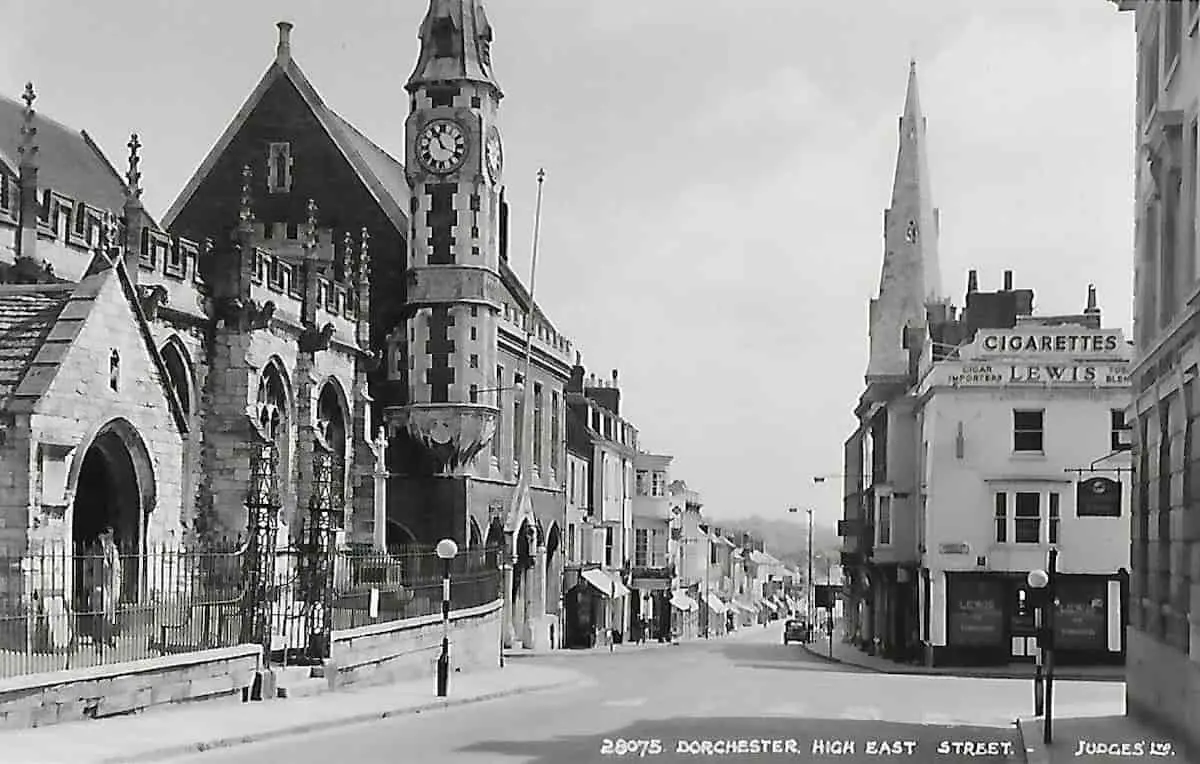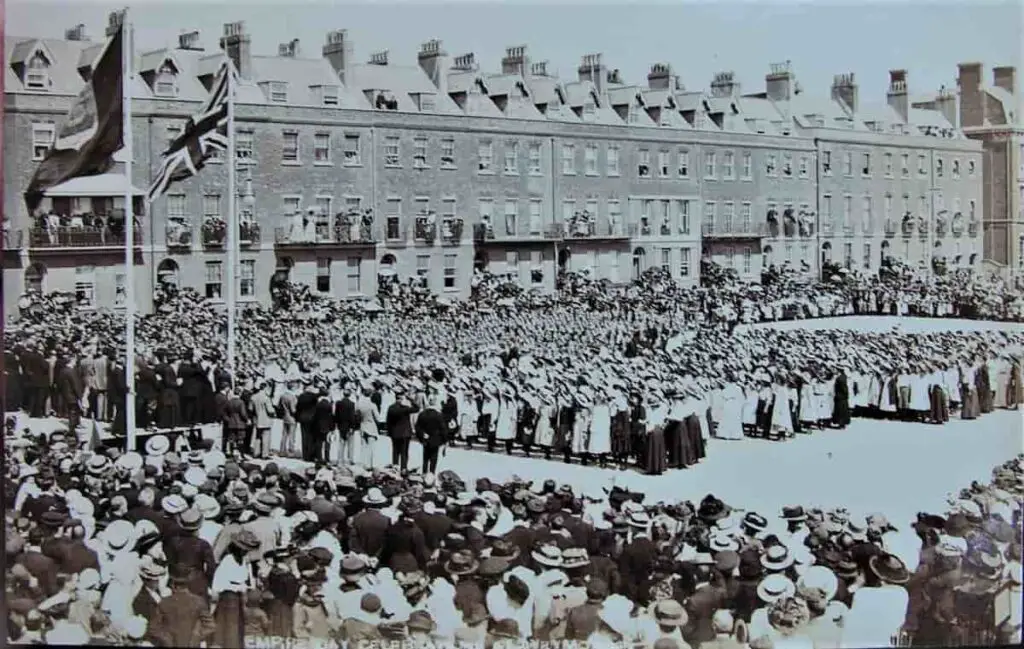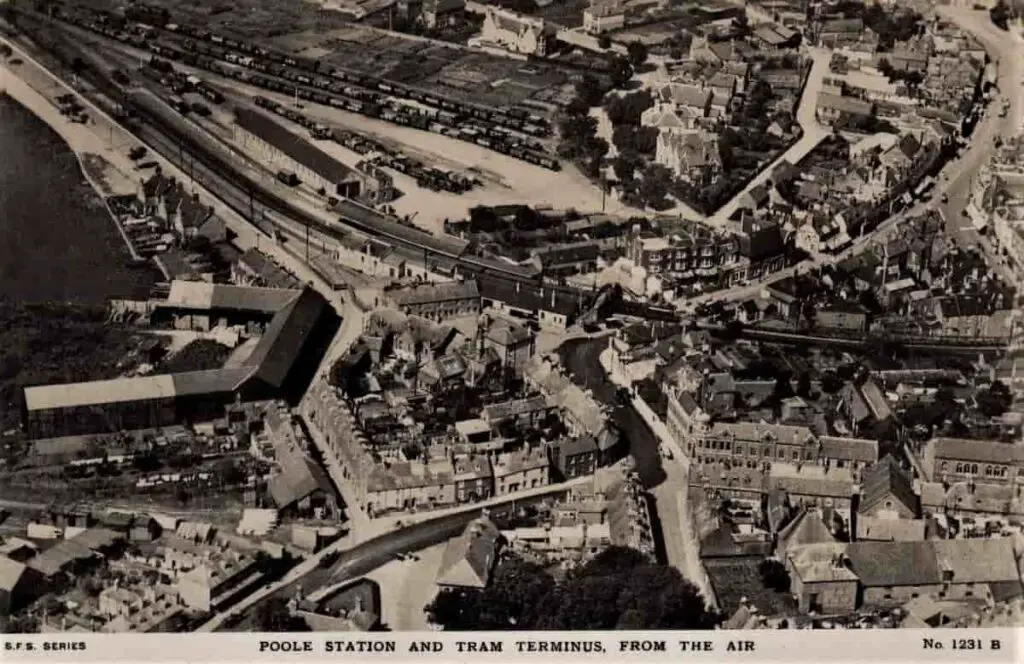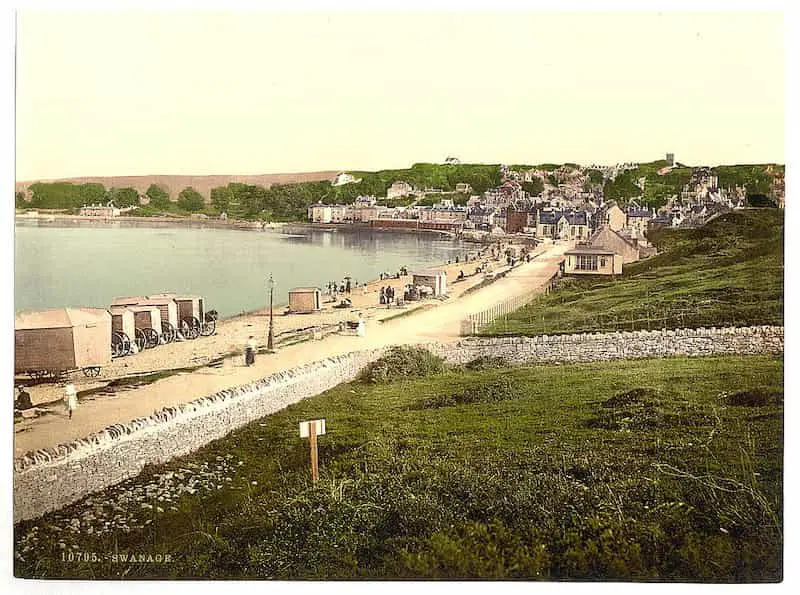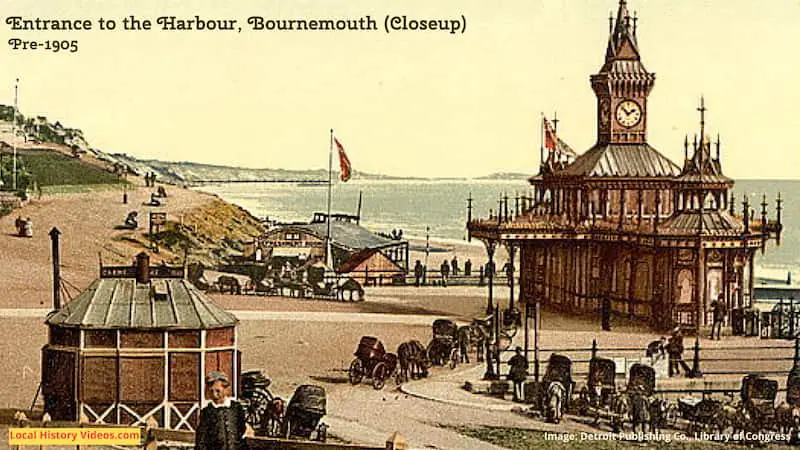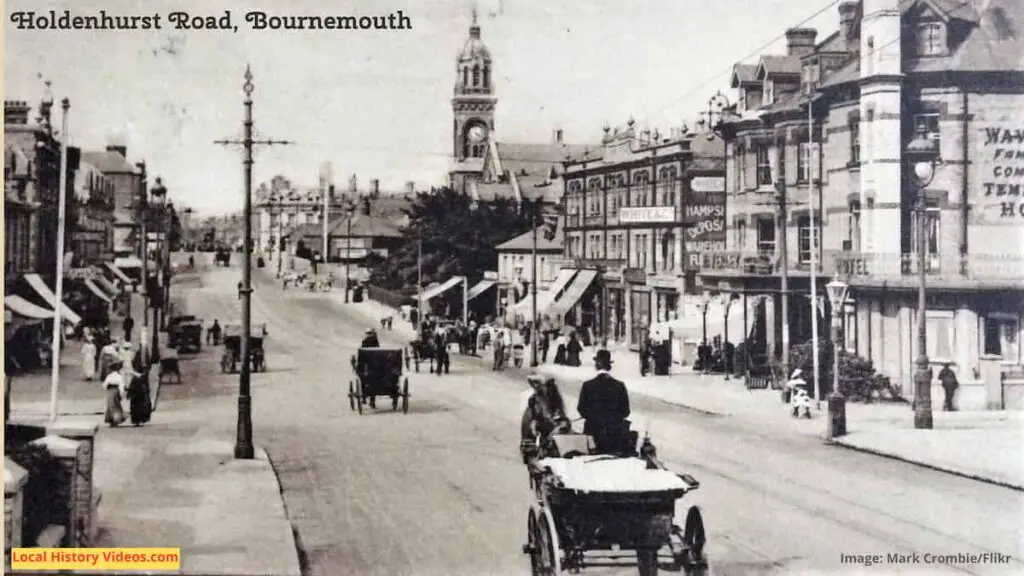Enjoy a glimpse of history through old images of Dorchester, in Dorset, England, UK.
Old Photos of Dorchester
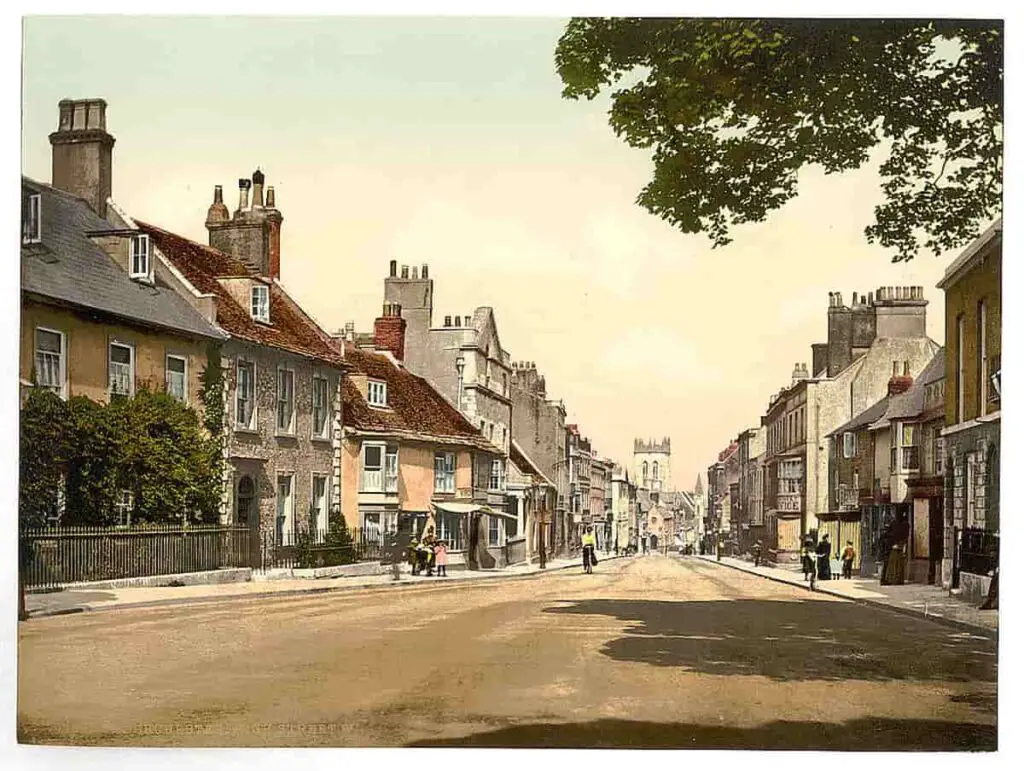
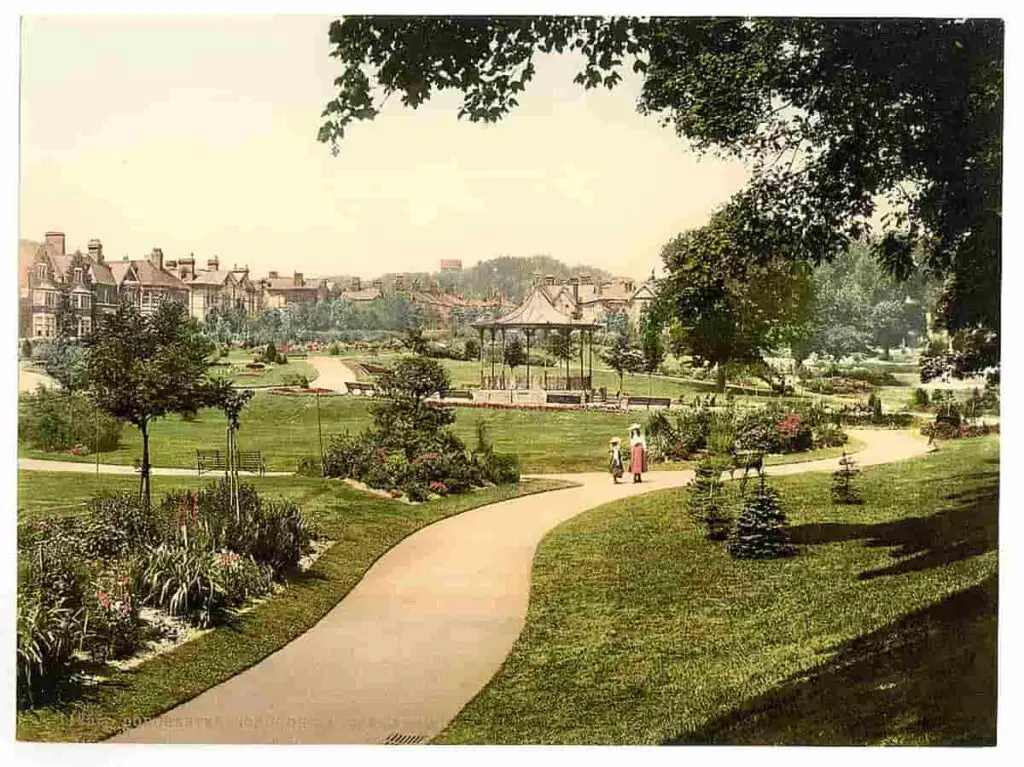
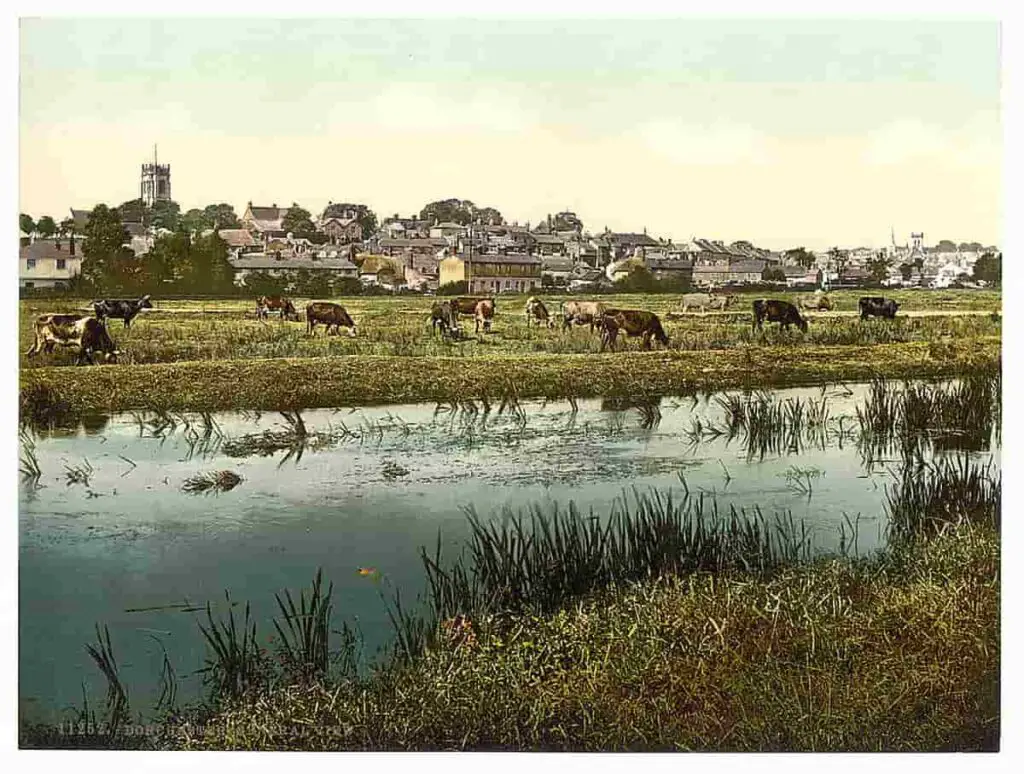
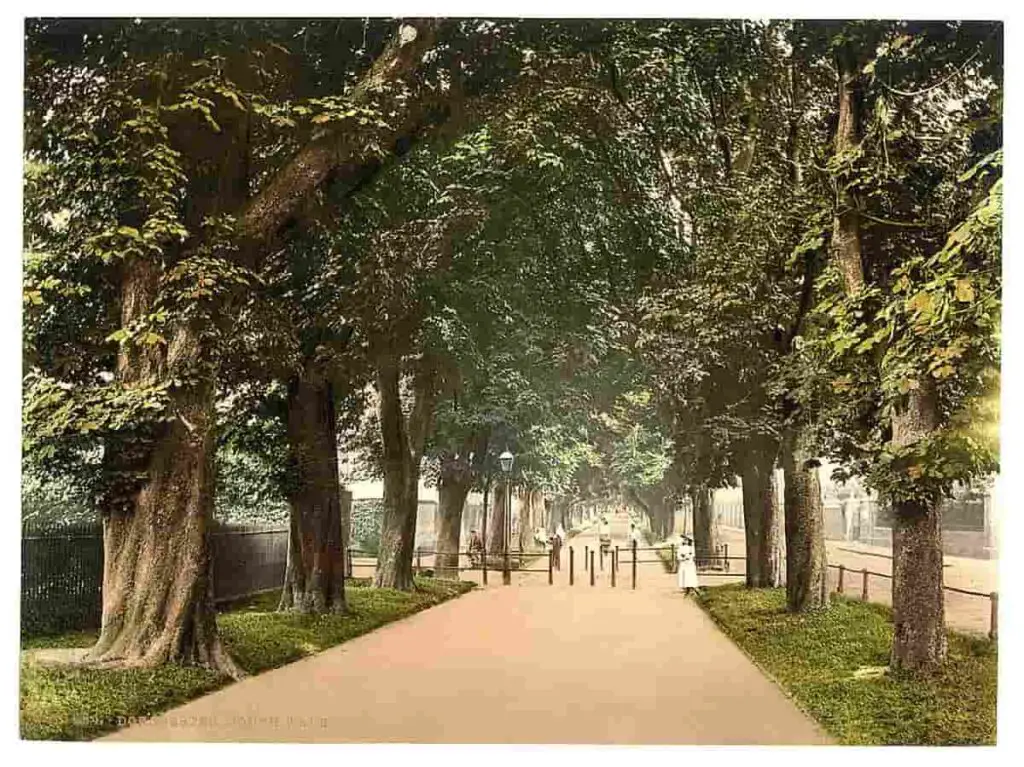
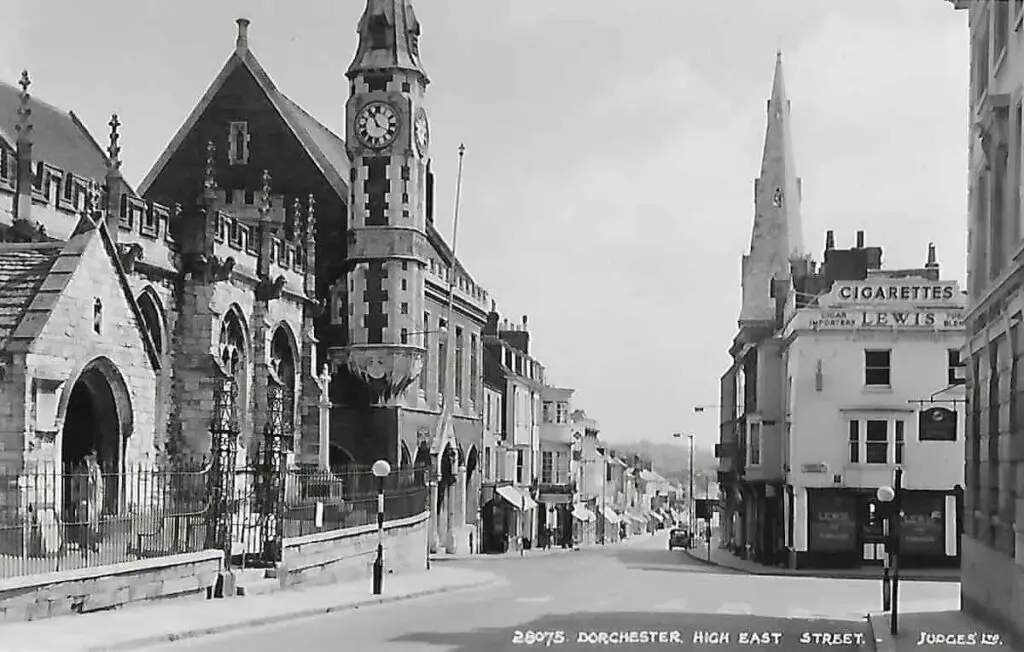
Dorchester in 1936
In 1936, the Lord Mayor of London made an official visit to Dorchester, in an event containing much pomp and ceremony.
Luckily, the procession was captured on film, showing several building in the background, and many of the local people who turned out to watch the spectacle.
The second world war began just three years later.
Lord Mayor Of London’s Visit To Dorchester (1936) – British Pathé on YouTube
A Bit of Dorchester History
Extract from:
The History of Dorchester During the British, Roman, Saxon, and Norman Periods
With an Account of Its Present State
by James Savage
Published in 1833
Pages 206 – 216
COUNTY GAOL.
The county gaol stood anciently where the public-house, called the Angel, was situated. Before 1633, a new gaol was built, at the lower end of East-street; and John and William Churchill, having accommodated the county with houses to erect it, it was ordered by the sheriff and the magistrates, that all grain used in the gaol, should be ground at their east mills, in Fordington; and if the gaoler bought his bread and beer, he should buy it of those who ground their corn at those mills.
The present gaol is situated on the north side of the town, nearly on the site of the ancient castle. The old gaol, which was small and inconvenient, was sold by auction for £1,220. In the new building are united the county gaol, the penitentiary house, and house of correction. The plan adopted is that recommended by the late Mr. Howard. The expense of erecting this building was £16,179. 10s. 6d.
This edifice, in its external appearance, is peculiarly handsome and characteristic; and the interior possesses every convenience appropriate to its destination. The building consists of a lodge, keeper’s house, chapel, debtors’ day room, female fines, and female debtors’ rooms, visiting rooms for male debtors, fines, felons’ infirmaries, & c., and of four wings, detached from, but communicating with, the centre building on each story, by means of cast-iron bridges from the several galleries.
There are separate sleeping cells for eighty-eight prisoners, which are distributed in the several buildings; and two airy dormitories for male debtors, each containing four beds, to be used in case the number exceeds that which can be accommodated in the debtors’ wing; besides four cells for condemned prisoners, light and airy; four over these perfectly dark, yet airy, for the refractory; and six reception cells, which last are fitted up in the lodge.
The distribution is such, that not only the male prisoners are separated from the female, and the felons from the debtors, fines, & c., but those of each description are subdivided into classes; and for each class, by means of distinct staircases, separate subdivisions are appropriated, with courts, workrooms, & c. To each. The female fines and female debtors have each a commodious room, with every possible convenience. Over the male debtors’ dormitories, and under the two infirmaries, separate and detached from every part of the building, except the keeper’s house and court, to which they have access through the chapel.
In the reception cells, in the lodge, prisoners are placed immediately on their entrance, until they can be examined by the surgeon, and thoroughly cleaned, for which purpose there are a hot and a cold bath. If in a foul or infectious state, they remain there until the surgeon pronounces them fit to be removed into the interior parts of the prison.
They are then sent to their proper classes; and all felons are apparelled in the gaol uniform; and their own clothes, if fit to be preserved, are fumigated in a kiln, and laid in the wardrobe until their liberation, or are delivered to the care of their friends.
There are also two rooms in the lodge, for the habitation of the task – master, and a small one for one of the turnkeys; a wardrobe; a room containing one of Stockdale’s mills for grinding corn, and every other requisite for grinding and for dressing the flour, where all the corn used for supplying the prison is ground, and which is found to answer extremely well; a committee – room for the magistrates to transact business in; an office for the governor of the gaol; a bakehouse and brewhouse, with iron boilers, an oven, and other conveniences for cooking for the prisoners; and on the top of the lodge there is a flat roof covered with copper, on which executions take place in view of all the criminal prisoners.
The governor of the gaol is Mr. R. W. Andrews; and the chaplain, the Rev. D. Clemetson. The surgeon is Mr. Arden. The regulations for the government of this prison correspond in propriety and utility with the excellence of the building, and altogether confer the highest credit on the persons concerned.
Many Roman coins were discovered in digging the foundation of the prison; and among others of Antoninus Pius, Vespasian, Constantine, Carausius, Saloninus, Valerian, Valens, and Gallienus.
COUNTY HALL.
The county-hall is a plain neat building, situated in High West-street. It has a front of Portland stone, and a pediment in the centre. The courts are well contrived, and commodiously fitted up; and the building is altogether suited to the purposes for which it was erected.
THE TOWN-HALL.
The town-hall is situated adjoining St. Peter’s church-yard. It was erected by the corporation in the year 1791, and is a spacious and handsome edifice. The butter and poultry markets are held under it, and behind are two rows of convenient shops for the use of the town butchers.
ASSIZES AND SESSIONS.
The county of Dorset is in the western circuit. The assizes, both in the spring and summer, are held in the county-hall, at this town. The quarter sessions for the county, as well as those of the corporation of Dorchester, are also held in the county hall.
MARKETS AND FAIRS.
There are two markets weekly at Dorchester, namely, on Wednesday and Saturday. The latter is the principal one; it is well supplied with the finest beef, mutton, lamb, veal, and pork, according to the season; poultry, game, & c. & c. There are four fairs annually, on Feb. 12th, for cattle and sheep; on Trinity Monday, and July 5th, for cattle, sheep, and lambs; and on August 5th, for cattle, sheep, lambs, wool, and leather. It is estimated that six hundred thousand sheep were formerly grazing within six miles around this town, and their number is said to have greatly increased of late years.
BANKS.
There are two banking establishments in Dorchester, namely, that of Messrs. Williams, Cox, Williams, and Williams; and that of Wm. Eliott, esq. Both these banks are situate in High West street; and they both draw on Messrs. Williams, Deacon, & Co., Birchin-lane, London.
SAVINGS BANK.
The Savings Bank was established on the 20th of January, 1818, for the purpose of securing deposits of money, belonging to the industrious classes of the town and neighbourhood of Dorchester.
This institution has been found, in common with others of the same description, to have excited a spirit of economy, industry, and independence, amongst those classes of persons in society who are disposed to avail themselves of the advantages to be derived from it.
The sum actually invested with the commissioners for the reduction of the national debt, including interest, on the 20th of November, 1831, was £42,590. 8s. 3d., to which is to be added £500, invested on account of the surplus fund, and £278. 6s. 3d. in the hands of the treasurer, making together the sum of £43,368. 14s. 6d. The rate of annual interest allowed to the depositor is £3. 8s. per cent. Deposits of not less than one shilling are received, which bear interest from the first day of the month next after the sums so deposited amount to twelve shillings and sixpence. The number of depositors at the above-mentioned date were 360 whose respective balances did not exceed £20 each, …… £3,233 10 2, 272 ditto above £20, and not exceeding £50, …… 8,334 18 10 100 ditto above £50, and not exceeding £100, ….. 70 ditto above £100, and not exceeding £150, … 35 ditto above £150, and not exceeding £200, … … 19 ditto above £200, …… 10,748 3 7 8,443 5 0 5,840 14 10 5,089 7 5 916 Total number of depositors, 41,689 19 10 3 Charitable societies, 93 3 1 10 Friendly societies, 904 10 10 929 Total number of accounts. On separate surplus account, Surplus accrued in 1831, 500 0 0 181 09 Total, …… £43,368 14 6
A depositor is at liberty to withdraw the whole, or any part, of his money so deposited, at a week’s notice, provided it does not exceed £5; but if it should amount to more than that sum, then a fortnight’s notice is required.
The Actuary is Mr. B. Jacob, High-East Street.
POST OFFICE
Near The Post Office is in High-East-Street, the King’s Arms Inn. The postmaster is Mr. John Pett.
Letters from London and the east arrive every morning at a quarter before ten, and are despatched every afternoon at four. Letters from Exeter, Plymouth, Falmouth, and the west, arrive at four in the afternoon, and are despatched every morning at a quarter past ten. Letters from Cerne and Sydling, arrive every afternoon at a quarter before four, and are despatched every morning at a quarter past ten. Letters from Charminster, Stratton, Frampston, Maiden Newton, Cattistock, Evershot, and Melbury, arrive every afternoon at a quarter before four, and are despatched every morning at a quarter past ten. Letters from Weymouth arrive every morning at thirty-five minutes past nine, and at half-past four in the afternoon; and are despatched every morning at ten, and at half-past four in the afternoon.
VACCINE INSTITUTION
Amongst the great number of benevolent and charitable institutions patronized and supported by the nobility, clergy, and gentry, of the county of Dorset, it is remarkable that not one, having for its object the prevention and extinction of so loathsome and dangerous an epidemical disease as the small pox, should have before the year 1831, engaged the public attention. To effect so desirable and benevolent a purpose as the establishment of a vaccine institution in the county town of Dorchester, for the inoculation of the children of the poor with the vaccine pock, and to prevent the dangerous effects which have on many occasions been experienced by the spreading of that fatal disease, the small pox, Mr. SHORLAND, Surgeon, in Dorchester, commenced an institution, in imitation of the National Vaccine Institution and the Royal Jennerian Society in London, where the poor may have their children inoculated with vaccine matter, GRATIS, at his house in Dorchester, every Monday, Wednesday, and Friday, from nine to ten in the morning.
HORTICULTURAL SOCIETY.
The Dorsetshire Horticultural Society was established in 1830; it is supported by subscription, and is conducted by a general committee annually chosen, consisting of eighteen members, and a sub-committee of nine members, with power to add to their numbers. A president, six vice-presidents, a treasurer, and a secretary, are also chosen annually. Three members of the general committee, and three of the sub-committee, are a quorum, for transacting the affairs of the society. Every annual subscriber of ten shillings and sixpence is deemed a member of the society, and qualified to exhibit specimens in competition for prizes. The payment of five pounds constitutes a member for life. There are three annual meetings in the year, at Dorchester, Blandford, and Sherborne, for the exhibition of flowers, plants, fruits, and vegetables, and for the distribution of prizes.
The society, at each exhibition, also awards to a second class of competitors, consisting of laborers in husbandry, not being subscribers, prizes for horticultural productions of their own growth of superior merit. All members exhibiting specimens of fruit and vegetables, shall, if required, state the particular mode of culture of such specimens, and as far as may be practicable, use his best endeavours in promoting the extended growth of such fruit or vegetable.
The treasurer of this society is Robert Pattison, Esq., and the secretary, Mr. Benjamin Jacob, of Dorchester.
READING ROOMS AND LIBRARIES.
There are three circulating libraries in Dorchester, first, that of Mr. G. Clark, in South street; the second, that of Messrs. B. and J. Jacob, in High-East-Street; and the third, that of Mr. Patch, in High-West-Street.
The reading rooms are at Mr. G. Clark’s, in South-Street; and at Mr. Patch’s, in High West-Street.
NEWSPAPER.
The “Dorset County Chronicle and Somersetshire Gazette” was commenced on the 4th of January, 1821, and is published by Messrs. Weston, Simonds, and Sydenham, at the Office on the Cornhill. It is conducted on conservative principles, and in unison with those of the Church of England, and in the present conflicting state of public opinion, advocates those principles with a devotion worthy of its high patronage; and from its being the organ of all the public business of the county of Dorset, it enjoys a very numerous and highly respectable circulation, which is constantly increasing.
THEATRE.
There is a small, but neat Theatre, situate in Back-West-Street, which was erected in 1828, and opened on the 22d of February, in that year, by Mr. Henry Lee, with the Comedy of “John Bull,” and the Farce of “The Spoil’d Child.” The present company, under the management of Mr. Herbert Lee, perform here once in two years, and exhibit considerable dramatic talent. Mr. H. Lee in the selection of his performances, constantly evinces a cultivated taste and superior knowledge of the English drama.
BILLIARD ROOM.
There is a subscription billiard room kept at Mr. Bonifas’s, on the Cornhill. Some periodical publications are also to be found here.
RACES.
The Races are held annually, about the first week in September, and are numerously and fashionably attended. The course is in the vicinity of Maiden Castle. The racing is good, and for two days draws to Dorchester all the principal families of the nobility and gentry in the county, and also from more distant parts.
More Pictures of Old Dorchester
Old Dorchester in Dorset, England, enjoyed through historic photos, vintage pictures & archive film. Browse history in these fascinating old images of a bygone era on my Pinterest Board.
More about Dorset
- Old Images of Weymouth, EnglandGlimpse history through old images of Weymouth, Dorset, England.
- Old Images of Poole, DorsetGlimpse history through old images of Poole, in Dorset, England, UK.
- Old Images of Swanage, DorsetGlimpse history through old images of Swanage, in Dorset, England.
- Dorchester, England: History in Old ImagesEnjoy a glimpse of history through old images of Dorchester, in Dorset, England, UK. Old Photos of Dorchester Dorchester in 1936 In 1936, the Lord Mayor of London made an official visit to Dorchester, in an event containing much pomp and ceremony. Luckily, the procession was captured on film, showing several building in the background,… Read more: Dorchester, England: History in Old Images
- Old Images of Dorset, EnglandGlimpse history through old images of Dorset, England.
- Edward Craven Walker, Lava Lamp InventorDiscover how the inventor and filmmaker Edward Craven Walker came up with the idea for what became known as the Lava Lamp.
- Old Images of Bournemouth, DorsetEnjoy a glimpse of history through old images of Bournemouth, Dorset, England, UK.
- Dorset: Local History ResourcesPage Contents An Introduction To Dorset Cities In Dorset Towns And Villages In Dorset Dorset History Facebook Groups Dorset Local History Resources

